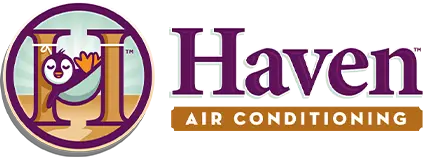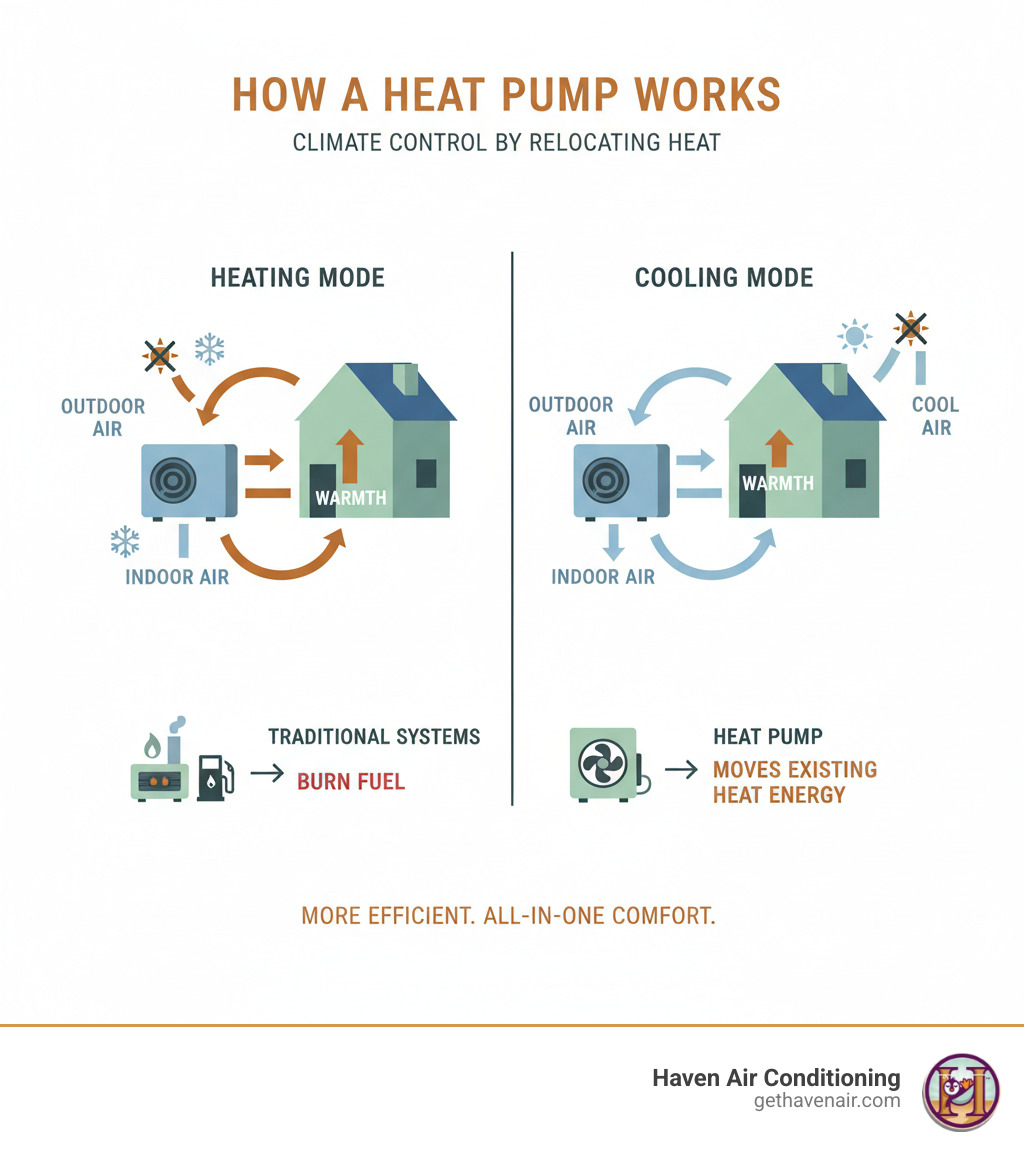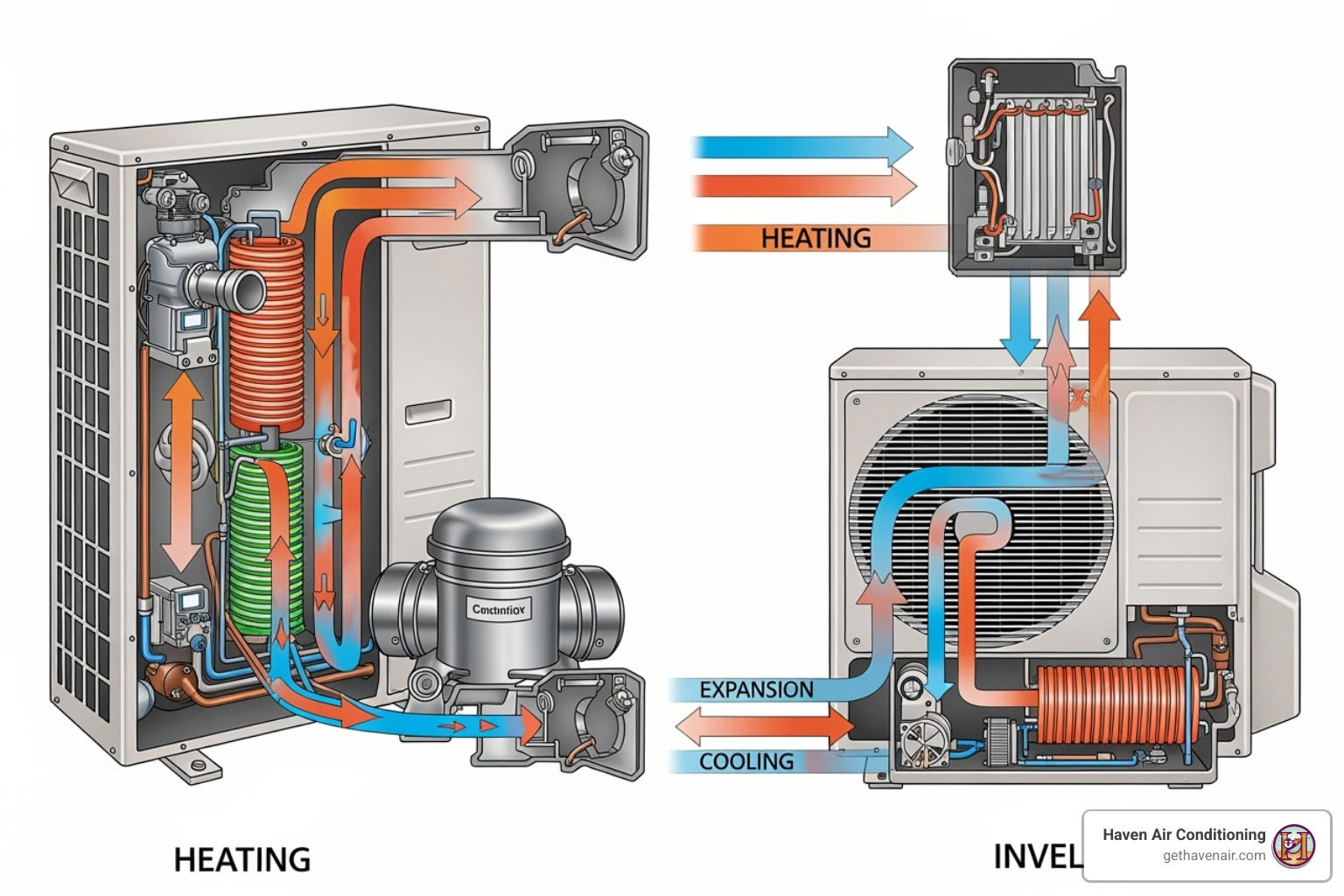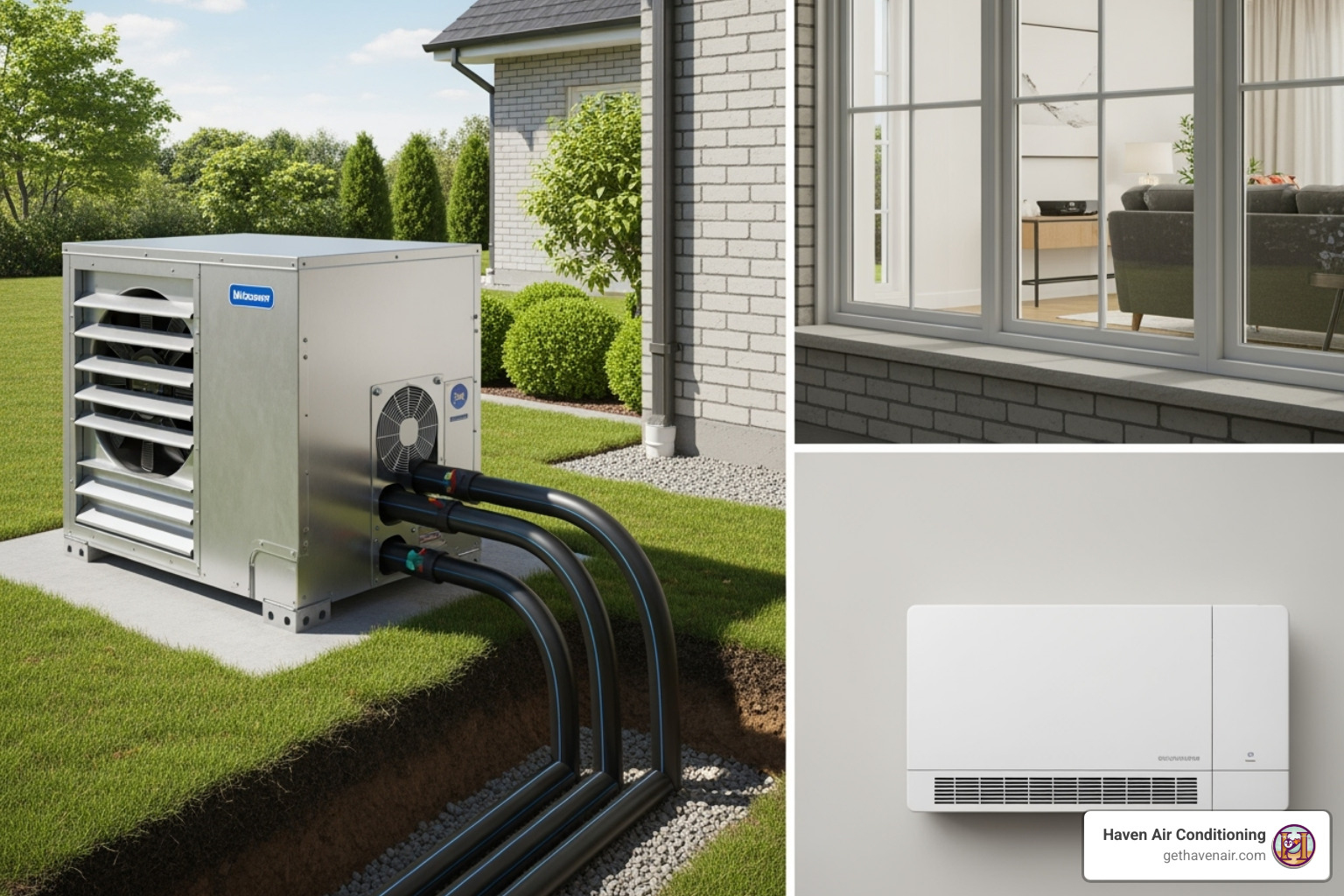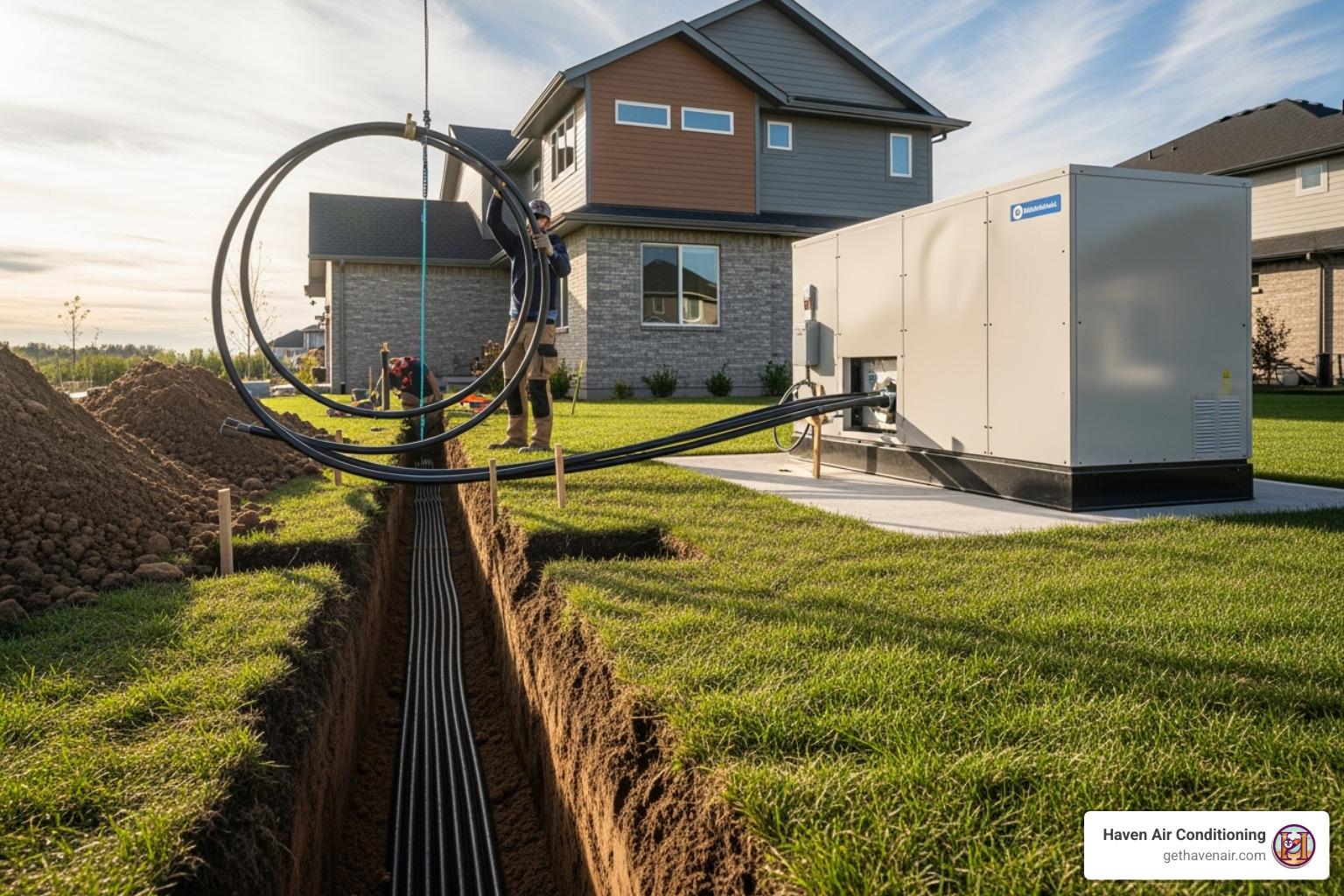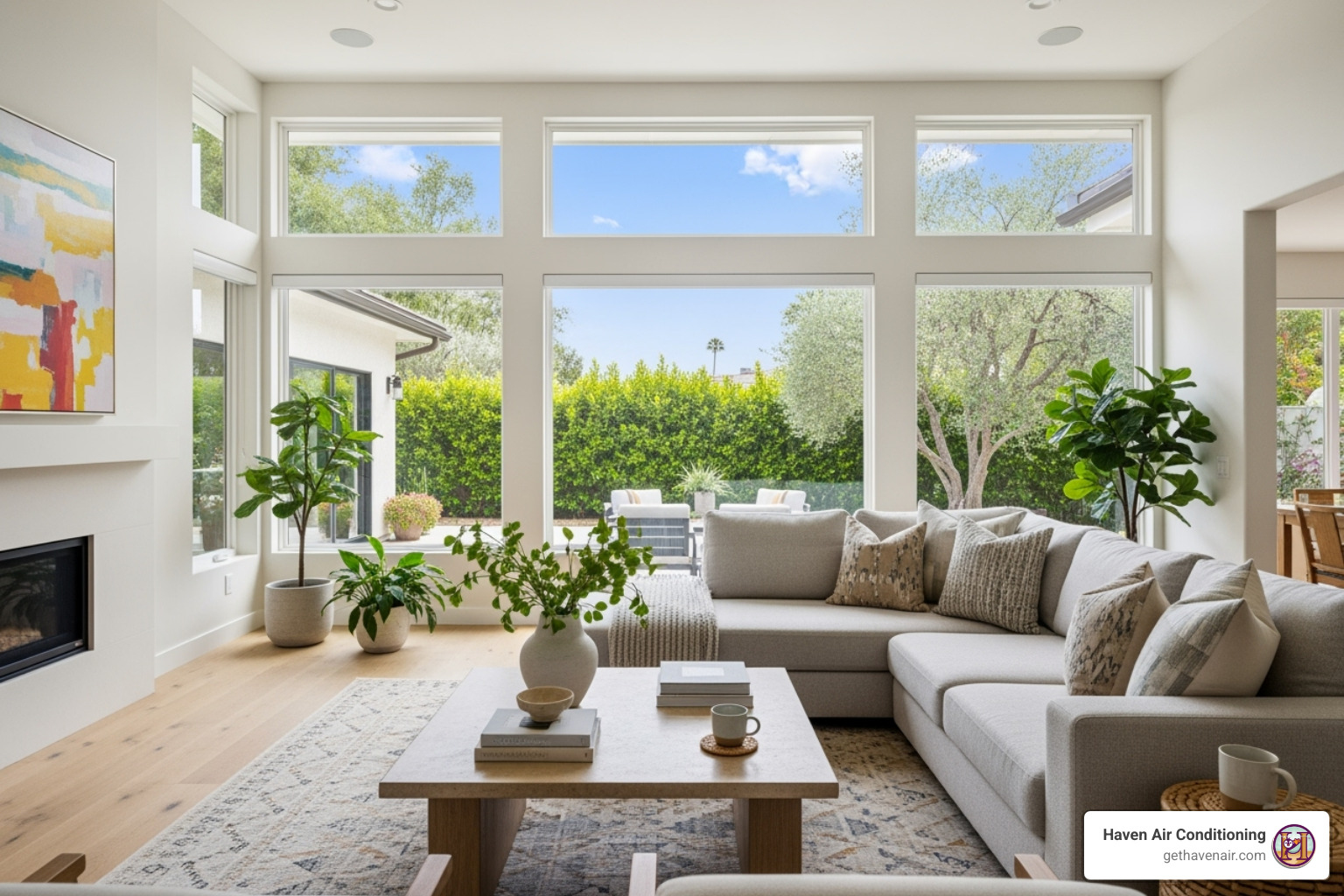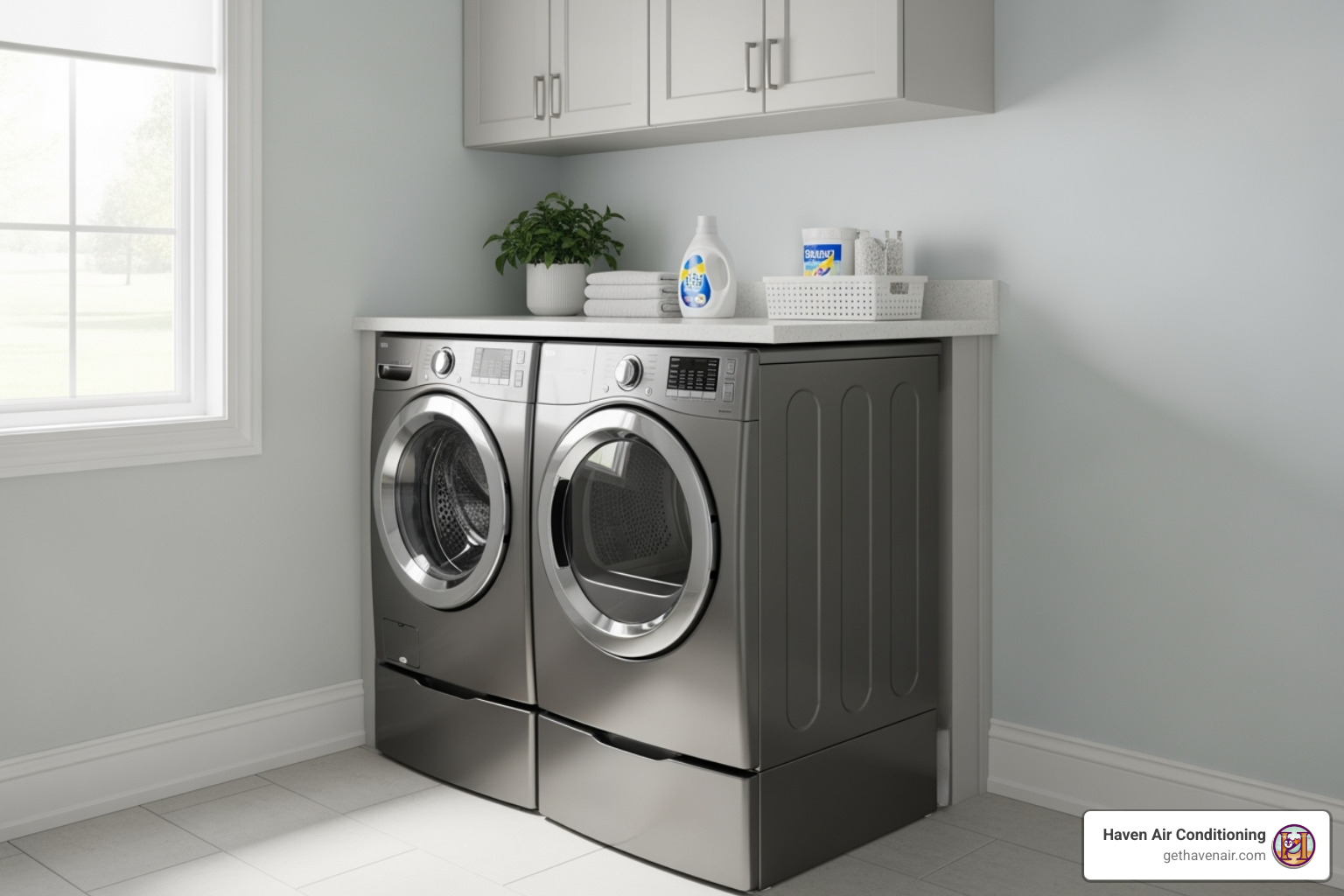Your All-in-One Climate Control Solution
An ac heat pump is a versatile HVAC system that both heats and cools your home by transferring heat rather than generating it. Unlike traditional systems that require separate air conditioners and furnaces, a heat pump handles year-round comfort with a single unit, making it an energy-efficient choice for Orange County homeowners looking to upgrade their climate control.
What You Need to Know About AC Heat Pumps:
- Dual Function: Provides both heating in winter and cooling in summer using one system
- How It Works: Moves existing heat from one place to another instead of burning fuel or using resistance heating
- Energy Efficiency: Can be two to five times more efficient than traditional heating methods
- Types Available: Air-source (most common), ground-source (geothermal), and ductless mini-split systems
- Cost Savings: Can reduce heating costs by up to 75% compared to electric resistance heating
- Climate Suitability: Modern cold-climate models work efficiently even in subfreezing temperatures
Whether you’re replacing an aging furnace and air conditioner or installing climate control for the first time, understanding how heat pumps work helps you make an informed decision. For comprehensive guidance on heat pump technology, explore our detailed article on what is a heat pump and how does it work. If you’re ready to discuss installation options for your Orange County home, contact our team for expert heating and cooling solutions.
How an AC Heat Pump Works: The Science of Comfort
Your ac heat pump doesn’t create heat—it cleverly moves it from one place to another, much like a refrigerator in reverse. It uses a closed-loop system where refrigerant circulates, absorbing and releasing heat as it changes between liquid and gas.
This process relies on the refrigerant cycle and heat transfer principles. The refrigerant picks up thermal energy in one location and deposits it elsewhere. The compressor pressurizes the refrigerant to raise its temperature, while the expansion valve reduces pressure to cool it. This cycle allows the heat pump to move large amounts of heat with minimal electricity.
The key component is the reversing valve. This device changes the refrigerant’s flow direction, allowing the system to switch between heating and cooling modes. Without it, a heat pump would just be an air conditioner. To learn more about this fascinating process, check out how a heat pump works from Energy Star’s experts.
How It Cools Your Home (Summer Mode)
When Orange County temperatures climb, your ac heat pump functions like a standard air conditioner. Refrigerant absorbs heat from your indoor air via the evaporator coil. This heated refrigerant then travels to the outdoor unit, where it releases the captured heat outside.
Besides cooling, the system also dehumidifies your home. As warm, humid air passes over the cold indoor coil, moisture condenses and is drained away. This dual action creates a cooler, drier, and more comfortable environment, perfect for Southern California summers.
If you’re wondering how this compares to a traditional AC unit, we’ve covered the details in our article on heat pumps vs air conditioning. Spoiler alert: the cooling performance is virtually identical.
How It Heats Your Home (Winter Mode)
When temperatures drop, your ac heat pump reverses its operation to bring warmth indoors. Even on chilly Orange County mornings, the outdoor air contains heat energy. Your heat pump extracts this ambient heat from outside using its refrigerant.
The compressor then pressurizes this refrigerant, raising its temperature. This superheated refrigerant flows to your indoor unit, where it releases warmth into your home through the air handler. It’s the cooling process in reverse, moving heat from outside to inside.
Some systems include auxiliary heat strips—electric resistance heaters that activate when outdoor temperatures fall below the heat pump’s optimal range. Modern cold-climate heat pumps are remarkably capable, maintaining efficiency down to -15°F. This means they can handle most heating needs in our moderate climate without backup.
If your system ever seems to be struggling or you notice your heat pump blowing cold air during heating season, that’s a sign something needs attention. For troubleshooting heating issues, our guide on my heat pump is not heating can help identify the problem.
Key Components of an AC Heat Pump System
Knowing the components of your ac heat pump helps you understand how it works. The outdoor unit (condenser) contains a coil and fan to release or absorb heat. The indoor unit (air handler) distributes conditioned air through your ductwork.
The compressor is the system’s heart, pressurizing and circulating the refrigerant. The refrigerant (like R-410A) is the fluid that carries heat as it cycles between liquid and gas.
Connecting everything are the refrigerant lines, copper tubes that link the indoor and outdoor units. The expansion valve regulates refrigerant flow and pressure. The crucial reversing valve is the switch that determines whether your system heats or cools by changing the refrigerant’s flow direction.
Each component works together to keep your Orange County home comfortable year-round.
Types of Heat Pumps: Finding Your Perfect Match
Just as every home is unique, so are the different types of ac heat pump systems available. Choosing the right one depends on your home’s layout, your climate, your budget, and how you prefer to manage comfort in different rooms. Let’s explore the three main options to help you find your perfect match.
Air-Source Heat Pumps
The most common type you’ll find in Orange County and across the country is the air-source heat pump. These systems do exactly what their name suggests—they transfer heat between your home and the outdoor air. It’s a straightforward approach that works beautifully in our Southern California climate.
Air-source heat pumps excel at working with existing ducted systems, making them an ideal choice if you’re replacing an older furnace and air conditioner setup. Your existing ductwork stays in place, and the new heat pump simply takes over the job of both units. This air-to-air heat transfer method has become incredibly sophisticated in recent years, with modern models now performing reliably even in regions with harsh winters and extended subfreezing temperatures.
The technology has advanced so much that air-source systems are now considered a legitimate heating solution in nearly every climate zone. For a comprehensive look at how these systems work and their benefits, the Department of Energy offers detailed information on air-source heat pumps.
Ground-Source (Geothermal) Heat Pumps
If you’re looking for the ultimate in efficiency, ground-source heat pumps—often called geothermal systems—are the gold standard. Instead of dealing with the temperature swings of outdoor air, these systems tap into the remarkably stable temperatures found just a few feet below the earth’s surface.
Here’s what makes them special: a network of underground pipes circulates fluid that exchanges heat with the ground. In winter, it absorbs warmth from the earth to heat your home. In summer, it releases your home’s heat back into the cooler ground. Because the ground maintains a consistent temperature year-round (typically around 50-60°F), these systems don’t have to work nearly as hard as air-source models.
The trade-off? Installation is more complex and requires excavation to install the ground loop system. However, the long-term benefits are impressive. High-efficiency geothermal systems can use 61% less energy than standard models, and the underground pipes can last 50 years or more. Many homeowners find that the exceptional efficiency and longevity make up for the higher initial installation complexity.
Ductless Mini-Split Heat Pumps
Ductless mini-split heat pumps offer a completely different approach—and they’re perfect for homes without existing ductwork. Whether you’re dealing with an older home, a new addition, a converted garage, or you simply want better control over different areas of your house, mini-splits provide an neat solution.
The system consists of an outdoor unit connected to one or more indoor air handlers through small refrigerant lines. No bulky ductwork needed. Each indoor unit can be controlled independently, giving you true zoned comfort. Want your bedroom cooler at night while keeping the living room warmer? No problem. This flexibility means you’re only conditioning the spaces you’re actually using, which translates to real energy savings.
Many mini-split systems also feature inverter technology, which is a game-changer for comfort and efficiency. Traditional compressors operate in simple on-off cycles, but inverter technology allows the compressor to adjust its speed continuously to match your exact heating or cooling needs. The result? More consistent temperatures throughout the day, quieter operation, and improved energy efficiency. Your home stays comfortable without the temperature swings you might experience with older systems.
The Benefits and Limitations of an AC Heat Pump
Choosing an ac heat pump for your home is a significant decision, and understanding both its advantages and its limitations will help you determine if it’s the right fit for your Orange County property. We’ve seen how these systems can transform home comfort while dramatically reducing energy bills. For a broader comparison of heating options, you might find our article on heat pumps vs furnaces: which is better? insightful.
Advantages: Energy Savings and Eco-Friendly Comfort
The benefits of opting for an ac heat pump are substantial, which is why we’re installing more of them every year in Orange County homes. The most compelling advantage? These systems don’t generate heat—they move it. This fundamental difference makes them remarkably efficient compared to traditional heating methods.
When it comes to energy savings, the numbers speak for themselves. Heat pumps can reduce your electricity use for heating by up to 75% compared to electric resistance heating like baseboard heaters. Even when compared to furnaces, they’re two to five times more efficient at converting energy into heat. High-efficiency models can generate savings of up to 40% on your electricity bills during heating season. The typical annual energy consumption of a heat pump ranges from 6,176 to 10,244 kilowatt hours, though this varies based on your home size, climate, and usage patterns.
Beyond your wallet, your environmental impact improves significantly with a heat pump. By reducing electricity consumption and eliminating the burning of fossil fuels for heating, these systems dramatically lower your home’s carbon footprint. Gas-fired furnaces, for instance, produce 45 to 70 percent more emissions than heat pumps. Research shows they have a significantly lower climate impact compared to traditional heating systems.
The year-round convenience of having one system handle both heating and cooling can’t be overstated. No more switching between separate units or wondering which system to maintain. Your ac heat pump provides consistent comfort throughout all seasons with a single, integrated solution.
Indoor air quality often improves with heat pumps too. During cooling cycles, they naturally dehumidify your home, reducing mold and mildew growth while creating a more comfortable environment. Many models also feature advanced filtration options that capture allergens and particles.
Safety is another often-overlooked benefit. Since heat pumps don’t burn fossil fuels, there’s no risk of carbon monoxide leaks or combustion byproducts in your home. And if you’re concerned about noise, modern heat pumps—especially variable-speed models—operate remarkably quietly, often no louder than your refrigerator.
Considerations: Performance in Extreme Climates
While modern ac heat pump systems are incredibly versatile, it’s worth understanding how they perform in temperature extremes. The good news? Technology has come a long way.
Cold climate performance has improved dramatically in recent years. While older heat pumps struggled when temperatures dropped, today’s models are superefficient and can deliver heat down to -15 degrees Fahrenheit. Some specialized cold climate models even function effectively down to -30°C. That’s well below anything we typically experience in Orange County, but it demonstrates how far the technology has advanced.
Every heat pump has what’s called a “balance point”—the outdoor temperature at which the system’s heating capacity exactly matches your home’s heating needs. Below this temperature, an auxiliary heating source might activate to supplement the heat pump. This could be electric resistance strips built into the system, or in dual-fuel setups, a traditional furnace. If you notice your heat pump is blowing cold air or struggling during cooler weather, give us a call to check it out.
On the flip side, extreme heat can also affect efficiency, though less dramatically. While your ac heat pump can absolutely cool your house when it’s 100°F outside, its efficiency does decrease somewhat in very high temperatures above 90°F. This can lead to slightly higher energy consumption during heat waves. However, for Orange County’s typical climate, heat pumps handle cooling beautifully and efficiently throughout our warm seasons.
The bottom line? For our Southern California climate, the advantages of an ac heat pump far outweigh any limitations. Professional installation and proper sizing ensure your system performs optimally year-round. For expert advice and professional heating installation services, our team is here to help you find the perfect system for your home.
Understanding Heat Pump Efficiency and Sizing
To get the most from your ac heat pump, you need an efficient model that’s properly sized for your home. An undersized unit will run constantly without providing comfort, while an oversized one will cycle frequently, wasting energy and wearing out parts.
This is why professional installation is critical. Our team performs a thorough assessment of your home—including insulation, square footage, windows, ceiling height, and Orange County’s specific climate conditions—to determine your exact needs. This attention to detail ensures your system works beautifully for years.
Decoding Efficiency Ratings (SEER, EER, & HSPF)
When shopping for an ac heat pump, you’ll see efficiency ratings. These acronyms help you understand how much heating and cooling you get for your money.
SEER (Seasonal Energy Efficiency Ratio) measures seasonal cooling efficiency. A higher SEER rating means more efficient cooling and lower summer electricity bills. Ratings range from a minimum of 14 up to 42 for advanced models.
EER (Energy Efficiency Ratio) measures cooling efficiency at a specific high temperature (usually 95°F), representing peak demand. It provides a snapshot of performance when the system works hardest. For geothermal systems, EERs range from 16.2 to 27.5.
HSPF (Heating Seasonal Performance Factor) measures seasonal heating efficiency. A higher HSPF means less electricity is needed to heat your home during chilly Orange County evenings. Ratings typically range from 7.1 to 13.2.
You might also see COP (Coefficient of Performance), which compares heating or cooling output to electrical input. At 46°F, air-source heat pumps have COPs of 2.0-5.4. At 18°F, they can still manage COPs of 1.1-3.7. Ground-source systems are even more impressive, with heating COPs from 3.8 to 5.0.
These ratings directly impact your wallet. Every residential heat pump sold in the United States displays an EnergyGuide label showing these efficiency numbers, making it easier to compare models.
Choosing the Right AC Heat Pump: Size and Speed
Sizing an ac heat pump correctly requires a professional load calculation, not just square footage. Capacity is measured in BTUs (British Thermal Units). Our technicians consider insulation, windows, ceiling height, occupancy, and home orientation to determine the exact capacity you need.
Beyond size, consider whether a single-speed or variable-speed system makes sense for your home. Single-speed heat pumps are either on at 100% capacity or off. This can cause temperature swings, noise, and a shorter lifespan due to stress from frequent cycling. Their main appeal is a lower upfront cost.
Variable-speed heat pumps operate more like a dimmer switch, modulating their speed (25-100%) to match your home’s needs. This provides consistent temperatures, better dehumidification, and quiet operation. Because they don’t cycle on and off constantly, components last longer and energy bills are lower. While the initial investment is higher, many find the comfort and savings worthwhile.
| Feature | Single-Speed Heat Pump | Variable-Speed Heat Pump |
|---|---|---|
| Operation | On/Off (runs at 100% capacity or off) | Modulates speed (runs at precise capacity needed, from 25-100%) |
| Comfort | Can lead to temperature swings | Consistent temperatures, fewer drafts, better dehumidification |
| Efficiency | Less efficient, higher energy consumption during operation | Highly efficient, lower energy consumption, especially at partial loads |
| Noise Level | Louder, noticeable starts and stops | Quieter, continuous low-level operation |
| Lifespan | Shorter component lifespan due to frequent cycling | Longer component lifespan due to reduced stress from constant starts/stops |
| Upfront Cost | Lower | Higher |
| Operating Cost | Higher | Lower |
| Ideal For | Budget-conscious, less concern for precise comfort | Homeowners seeking maximum comfort, energy savings, and quiet operation |
One final consideration: most residential heat pumps operate on 240V electricity. During installation, our certified technicians will verify that your home’s electrical service can safely support your new system. It’s details like these that ensure your ac heat pump operates safely and efficiently from day one.
Frequently Asked Questions about Heat Pumps
If you’re considering an ac heat pump for your Orange County home, you probably have questions—and you’re not alone! Here are the answers to some of the most common questions we hear from homeowners just like you.
What is the difference between a heat pump and a standard air conditioner?
Think of a standard air conditioner as a one-way street. It’s great at what it does—cooling your home by moving heat from inside to outside—but that’s all it can do. An ac heat pump, on the other hand, is more like a two-way street with a clever traffic director.
In the summer, it works exactly like a standard AC, removing heat from your home and releasing it outdoors. But here’s where the magic happens: in the winter, it reverses the process. It extracts heat from the outside air (yes, even cold air contains heat energy!) and brings it inside to warm your home. This reversing ability, made possible by a special component called a reversing valve, is what makes a heat pump a true two-in-one system for both heating and cooling.
What is the typical lifespan of a heat pump?
With proper installation and regular maintenance, you can expect a modern ac heat pump to serve your home reliably for 15 years or more. Some high-quality systems last even longer—ground-source heat pumps, for instance, can have indoor components that last 25 years, while their underground loops can keep working for 50+ years!
Several factors influence how long your heat pump will last. The quality of the unit itself matters, of course, but so do how often it runs, the climate conditions it faces, and most importantly, how well it’s maintained. Regular professional tune-ups are like regular oil changes for your car—they catch small issues before they become big problems and keep everything running smoothly. For a deeper dive into this topic, check out our article on how long does a heat pump last.
Are government incentives or rebates available for heat pumps?
Here’s some good news: yes, there are significant financial incentives available to help offset the cost of installing a high-efficiency ac heat pump! As governments and utilities increasingly support energy conservation and home electrification, various programs have emerged to make heat pumps more accessible.
At the federal level, the Energy Efficient Home Improvement Tax Credit can provide up to $2,000 per year in tax credits for qualifying heat pump installations. The High-Efficiency Electric Home Rebate Act (HEEHRA) goes even further, offering low- to moderate-income families up to $8,000 in point-of-sale discounts specifically for heat pumps. You can learn more about the HEEHRA program and how it might benefit you.
Beyond federal programs, California and many local utilities throughout Orange County offer their own rebates and incentives for energy-efficient HVAC upgrades. These programs change regularly and eligibility varies, so we always recommend checking with your utility provider and local government websites for the most current information. Our team at Haven Air Conditioning is also happy to point you in the right direction when you’re exploring your options for a new system.
Upgrade to All-in-One Comfort
Making the switch to an ac heat pump isn’t just about upgrading your HVAC system—it’s about changing the way you experience comfort at home. These remarkable systems deliver year-round climate control, wrapping your Orange County home in consistent warmth during those cooler winter mornings and refreshing coolness when summer arrives. And they do it all while using significantly less energy than traditional heating and cooling setups.
The benefits speak for themselves: exceptional energy savings that can reduce your heating costs by up to 75%, a dramatically smaller carbon footprint compared to fossil fuel systems, and improved indoor air quality through better humidity control and filtration. Whether you’re drawn to the versatility of an air-source system, the remarkable efficiency of a geothermal setup, or the flexible zoning capabilities of ductless mini-splits, there’s an ac heat pump solution perfectly suited to your home’s unique needs.
But here’s the thing—getting the full benefits of heat pump technology requires more than just picking the right model. Professional installation is absolutely critical to ensure your system is properly sized for your home, installed with precision, and set up to deliver peak performance for years to come. An incorrectly sized or poorly installed system won’t deliver the comfort or savings you’re expecting, no matter how efficient the unit itself is.
That’s where our team at Haven Air Conditioning comes in. We’re not just installers—we’re your partners in home comfort. Our certified technicians take the time to understand your home’s specific heating and cooling needs, recommend the ideal system for your situation, and handle every detail of the installation with the care and attention you deserve. We serve homeowners throughout the Greater Orange County Area, and we’re committed to making sure your ac heat pump performs flawlessly from day one.
Ready to experience the difference that all-season comfort and real energy savings can make? For expert advice and professional heating installation services, contact our team today. Your journey to a more comfortable, efficient home starts with a simple conversation.
